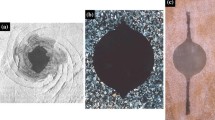Abstract
Borehole breakouts are formed by spalling of fragments in a direction parallel to the least horizontal stress. As the breakouts falling into the wellbore or being scoured by the drilling mud piece by piece, the stress concentration on the wellbore will release gradually. The wellbore is not circular or elliptical, which requires a numerical method to determine the redistributed stress around the irregular borehole. In this article, boundary element method associated with the brittle rock failure criterion is deployed to simulate the dynamic breakout of a borehole. The borehole shape is updated step by step during the time-dependent breakout. The first breakout volume is smaller than the analytical solution (Gholami et al. in J Rock Mech Geotech Eng 8:521–532, 2016). However, the total breakout volume is larger than the analytical solution because our model considers the subsequent failure of the irregular wellbore. The stress distribution around the irregular wellbore after each step of breakout is investigated and the maximum cohesive strength at which the rock will fail is figured out. These results provide new insights to understand the dynamic process of borehole breakout.











Similar content being viewed by others
References
Cuss RJ, Rutter EH, Holloway RF (2003) Experimental observations of the mechanics of borehole failure in porous sandstone. Int J Rock Mech Min Sci 40(5):747–761
Dresen G, Stanchits S, Rybacki E (2010) Borehole breakout evolution through acoustic emission location analysis. Int J Rock Mech Min Sci 47(3):426–435
Ghassemi A, Zhang Q (2004) A transient fictitious stress boundary element method for porothermoelastic media. Eng Anal Bound Elem 28:1363–1373
Gholami R, Aadnoy B, Rasouli V, Fakhari N (2016) An analytical model to predict the volume of sand during drilling and production. J Rock Mech Geotech Eng 8:521–532
Guenot A (1989) Borehole breakouts and stress fields. Int J Rock Mech Min Sci Geomech Abstr 26(3/4):185–195
Haimson B (2007) Micromechanisms of borehole instability leading to breakouts in rocks. Int J Rock Mech Min Sci 44(2):157–173
Ito T, Zoback MD, Peska P (2001) Utilization of mud weights in excess of the least principal stress to stabilize wellbores: theory and practical examples. SPE Drill Complet 16(04):221–229
Lekhnitskii SG (1968) Anisotropic plates. Gordon and Breach, New York
Mastin L (1988) Effect of borehole deviation on breakout orientations. J Geophys Res 93(B8):9187–9195
Walton G, Kalenchuk KS, Hume CD (2015) Borehole breakout analysis to determine the in situ stress state in hard rock. In: 49th US rock mechanics/geomechanics symposium, San Francisco, CA, USA, 28 June–1 July
Wang H, Towler BF, Soliman MY (2007) Near wellbore stress analysis and wellbore strengthening for drilling depleted formations. In: Rocky mountain oil & gas technology symposium, Denver, Colorado, USA, 16–18 April
Wen PH (1996) Dynamic fracture mechanics: displacement discontinuity method. Topics in engineering, vol. 29. Computational Mechanics Publications, Southampton
Zheng Z, Kemeny J, Cook NGW et al (1989) Analysis of borehole breakouts. J Geophys Res 94B(6):7171–7182
Zoback MD, Barton CA, Brudy M et al (2003) Determination of stress orientation and magnitude in deep wells. Int J Rock Mech Min Sci 40(7):1049–1076
Zou Y, Taylor WEG, Heath DJ (1996) A numerical model for borehole breakouts. Int J Rock Mech Min Sci Geomech Abstr 33(1):103–109
Acknowledgements
This research was supported by Hubei Provincial Natural Science Foundation of China (No. 2018CFB378). The authors wish to thank Dr. Guosheng Jiang for his helpful suggestions.
Author information
Authors and Affiliations
Corresponding author
Additional information
Publisher's Note
Springer Nature remains neutral with regard to jurisdictional claims in published maps and institutional affiliations.
Rights and permissions
About this article
Cite this article
Cheng, W., Jiang, G., Zhou, Z. et al. Numerical Simulation for the Dynamic Breakout of a Borehole Using Boundary Element Method. Geotech Geol Eng 37, 2873–2881 (2019). https://doi.org/10.1007/s10706-019-00802-7
Received:
Accepted:
Published:
Issue Date:
DOI: https://doi.org/10.1007/s10706-019-00802-7




